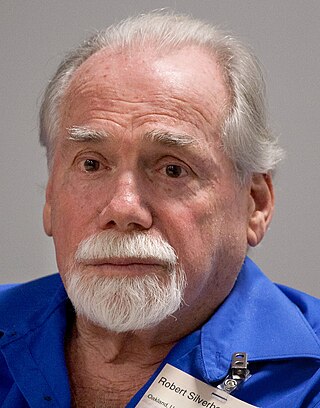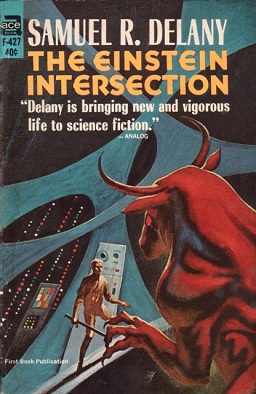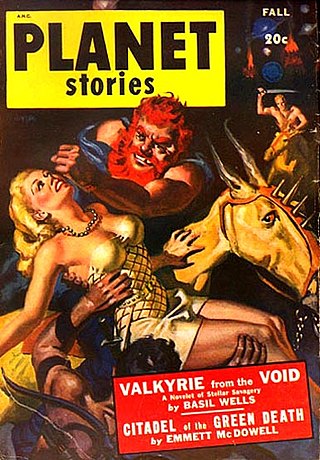
Alfred Elton van Vogt was a Canadian-born American science fiction author. His fragmented, bizarre narrative style influenced later science fiction writers, notably Philip K. Dick. He was one of the most popular and influential practitioners of science fiction in the mid-twentieth century, the genre's so-called Golden Age, and one of the most complex. The Science Fiction Writers of America named him their 14th Grand Master in 1995.

Laurence van Cott Niven is an American science fiction writer. His 1970 novel Ringworld won the Hugo, Locus, Ditmar, and Nebula awards. With Jerry Pournelle he wrote The Mote in God's Eye (1974) and Lucifer's Hammer (1977). The Science Fiction and Fantasy Writers of America gave him the 2015 Damon Knight Memorial Grand Master Award.

Robert Silverberg is an American author and editor, best known for writing science fiction. He is a multiple winner of both Hugo and Nebula Awards, a member of the Science Fiction and Fantasy Hall of Fame, and a Grand Master of SF. He has attended every Hugo Award ceremony since the inaugural event in 1953.

The Science Fiction Hall of Fame, Volume One, 1929–1964 is a 1970 anthology of English language science fiction short stories, edited by Robert Silverberg. Author Lester del Rey said that "it even lives up to its subtitle", referring to the volume's boast of containing "The Greatest Science-Fiction Stories of All Time".
The Golden Age of Science Fiction, often identified in the United States as the years 1938–1946, was a period in which a number of foundational works of science fiction literature appeared. In the history of science fiction, the Golden Age follows the "pulp era" of the 1920s and 1930s, and precedes New Wave science fiction of the 1960s and 1970s. The 1950s are, in this scheme, a transitional period. Robert Silverberg, who came of age in the 1950s, saw that decade as the true Golden Age. According to historian Adam Roberts, "the phrase Golden Age valorises a particular sort of writing: 'Hard SF', linear narratives, heroes solving problems or countering threats in a space-opera or technological-adventure idiom."
First Fandom Hall of Fame is an annual award for contributions to the field of science fiction dating back more than 30 years. Contributions can be as a fan, writer, editor, artist, agent, or any combination of the five. It is awarded by First Fandom and is usually presented at the beginning of the World Science Fiction Convention's Hugo Award ceremony.

Pluto has appeared in fiction as a setting since shortly after its 1930 discovery, albeit infrequently. It was initially comparatively popular as it was newly discovered and thought to be the outermost object of the Solar System and made more fictional appearances than either Uranus or Neptune, though still far fewer than other planets. Alien life, sometimes intelligent life and occasionally an entire ecosphere, is a common motif in fictional depictions of Pluto. Human settlement appears only sporadically, but it is often either the starting or finishing point for a tour of the Solar System. It has variously been depicted as an originally extrasolar planet, the remnants of a destroyed planet, or entirely artificial. Its moon Charon has also appeared in a handful of works.

NESFA Press is the publishing arm of the New England Science Fiction Association, Inc. The NESFA Press primarily produces three types of books:

The Einstein Intersection is a 1967 science fiction novel by Samuel R. Delany. The title is a reference to Einstein's Theory of Relativity connecting to Kurt Gödel's Constructible universe, which is an analogy to science meeting philosophy. Delany's intended title for the book was A Fabulous, Formless Darkness.
The Road to Science Fiction is a series of science fiction anthologies edited by American science fiction author, scholar and editor James Gunn. Composed as a textbook set to teach the evolution of science fiction literature, the series is now available as mass market publications. The six-volume set collects many of the most influential works of the genre. It was published originally by Signet and then by White Wolf Games Studio. Volumes 1 through 4 are currently being reprinted in paperback format by the company Scarecrow Press.

"Mars Is Heaven!" is a science fiction short story by American writer Ray Bradbury, originally published in 1948 in Planet Stories. "Mars Is Heaven!" was among the stories selected in 1970 by the Science Fiction Writers of America as one of the best science fiction short stories published before the creation of the Nebula Awards. As such, it was published in The Science Fiction Hall of Fame Volume One, 1929–1964. It also appears as the sixth chapter of The Martian Chronicles, revised as "The Third Expedition."

Great Science Fiction Stories About Mars is a 1966 anthology of science fiction short stories edited by T. E. Dikty and published by Fredrick Fell. Most of the stories had originally appeared in the magazines Startling Stories, Argosy, Thrilling Wonder Stories, Amazing Stories, Super Science Stories and Astounding SF.

In Search of Wonder: Essays on Modern Science Fiction is a collection of critical essays by American writer Damon Knight. Most of the material in the original version of the book was originally published between 1952 and 1955 in various science fiction magazines including Infinity Science Fiction, Original SF Stories, and Future SF. The essays were highly influential, and contributed to Knight's stature as the foremost critic of science fiction of his generation. The book also constitutes an informal record of the "Boom Years" of science fiction from 1950-1955.

Science Fiction: The 100 Best Novels, An English-Language Selection, 1949–1984 is a nonfiction book by David Pringle, published by Xanadu in 1985 with a foreword by Michael Moorcock. Primarily, the book comprises 100 short essays on the selected works, covered in order of publication, without any ranking. It is considered an important critical summary of the science fiction field.

Seekers of Tomorrow: Masters of Modern Science Fiction is a work of collective biography on the formative authors of the science fiction genre by Sam Moskowitz, first published in hardcover by the World Publishing Company in 1965. The first paperback edition was issued by Ballantine Books in October, 1967. A photographic reprint of the original edition was issued in both hardcover and trade paperback by Hyperion Press in 1974. Most of its chapters are revised versions of articles that initially appeared in the magazine Amazing Stories from 1961 to 1964.

Future Life, known as Future in its first year, was a science and science fiction magazine published from 1978 to 1981 by O'Quinn Studios. In the first year of its existence, the magazine was called "Future", then the name was expanded to "Future Life". Contributors included Harlan Ellison, Ed Naha, Boris Vallejo, and many others. It covered futuristic topics - largely space travel - as well as current scientific events of the time, and featured reviews of science fiction movies, books and comics, as well as interviews with Arthur C. Clarke, Anne McCaffrey, Ray Bradbury and many other scientists, artists and authors. The magazine was based in New York City.

Modern Masterpieces of Science Fiction is an anthology of science fiction short stories, edited by Sam Moskowitz. It was first published in hardcover by World Publishing Co. in 1965, and reprinted by Hyperion Press in 1974. It was split into three separate paperback anthologies published by MacFadden-Bartell; Doorway Into Time (1966), The Vortex Blasters (1968) and Microcosmic God (1968); the paperback editions omitted Moskowitz's introduction and the story by Robert Bloch.

Nebula Awards 21 is an anthology of award-winning science fiction short works edited by George Zebrowski, the second of three successive volumes under his editorship. It was first published in trade paperback by Harcourt Brace Jovanovich in December 1986, with a hardcover edition following from the same publisher in January 1987.

Nebula Award Stories Sixteen is an anthology of award winning science fiction short works edited by Jerry Pournelle and John F. Carr. It was first published in hardcover by Holt, Rinehart and Winston in August 1982; a paperback edition was issued by Bantam Books in September 1983. British editions were issued by W. H. Allen (hardcover) and Star (paperback) in 1983; the latter under the variant title Nebula Winners Sixteen.















